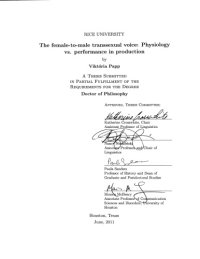
Ebook: The Female-to-Male Transsexual Voice: Physiology vs. Performance in Production
Author: Viktoria Papp
- Tags: transgender, FTM, transmen, LGBTQ+
- Year: 2011
- Publisher: Rice University
- Language: English
- pdf
Results of the three studies on the speech production of female-to-male transgender individuals (transmen) present phonetic evidence that speech produces the transmen by what I termed triple decoupling. Transmen successfully decouple gender from biological sex. The results of the longitudinal studies exemplified that speakers born and raised female do not necessarily need to have a female voicing source or filter function. Both qualitative changes can he achieved (to different degree) by bringing exogenous testosterone into the system that virilizes both source and filter over time. Moreover, the cross-sectional study showed that articulatory gestures can be modified to move the acoustic targets towards a gendered target one is striving to present. The acoustic manifestations of transmen with different partner attraction offers the next type of decoupling, that between sexual orientation and gender identity. The results of the cross-sectional study imply that female-born individuals attracted to men do not necessarily have to identify as women. They can opt out of this self-identification by selectively adopting features associated with the gay cismale speaking style. This is suggested by the fact that sexual orientation was found to have a significant effect on the durational and spectral quality of fricatives /s/ and /s/, formant values and sentential pitch range. Finally, the longitudinal studies provide evidence for the third type of decoupling, which comes in the form of gender breaking free from physiology. The recurring "reverse J-pattern" of both the transitioning source and filter, as well as the mean fundamental frequency raising above the pitch floor illustrate the fact that transmen do not feel obliged to sound as masculine (as low-pitched and "low-formanted") as testosterone enables them to. This final type of decoupling also serves to demonstrate that many transmen decidedly do not opt in to the binary system of sex / gender even though they are physiologically able to do so. Although LGB speaking styles have been investigated before, this dissertation is the first to discuss a number of acoustic descriptors specifically in transmen's speech and place them into the context of hormone treatment, sexual orientation and disclosure status.
Download the book The Female-to-Male Transsexual Voice: Physiology vs. Performance in Production for free or read online
Continue reading on any device:

Last viewed books
Related books
{related-news}
Comments (0)